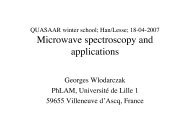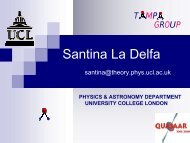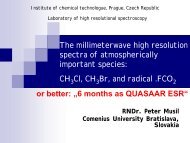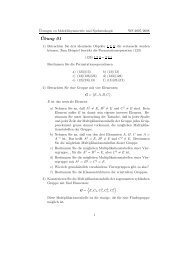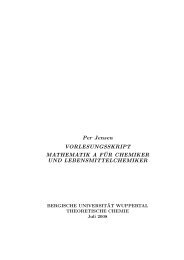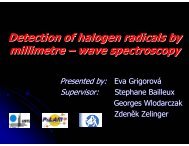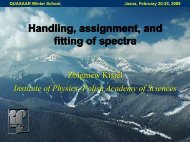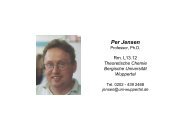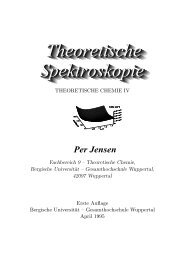Abstract book - Prof. Per Jensen, Ph.D. - Bergische Universität ...
Abstract book - Prof. Per Jensen, Ph.D. - Bergische Universität ...
Abstract book - Prof. Per Jensen, Ph.D. - Bergische Universität ...
- No tags were found...
You also want an ePaper? Increase the reach of your titles
YUMPU automatically turns print PDFs into web optimized ePapers that Google loves.
Contributed Lectures, N8 229Quantum Simulations of Helium Clusters with Open Shell and IonicDopantsJ. Jiang, M. Lewerenz, and M. MladenovićLaboratoire MSME, UMR 8208 CNRS, Université Paris Est (Marne la Vallée),5, Blvd. Descartes, 77454 Marne la Vallée Cedex 2, Marius.Lewerenz@univ-parisest.frJiang J.Lewerenz M.Mladenovic M.Many experiments on pure and doped helium clusters result in the production of a broaddistribution of charged fragment ions after electron impact or laser ionisation. These ionyield distributions can exhibit distinct stability patterns. We use the diffusion quantumMonte Carlo (DMC) technique to study these stability patterns and structural features ofhelium clusters with open shell atomic and molecular dopants, which can also arisefrom photodissociation processes. Recent experiments addressed the photodissociationof CH 3 I inside helium clusters. Simulations of these processes require reliable manybodypotentials which we construct from high level ab initio CCSD(T) calculations forseveral electronic states mixed by spin-orbit coupling and including non-additiveinteractions arising from induction. For small clusters numerically exact calculations ofrovibrational properties are used to establish the quality of our potential surfaces.We present steps towards the modelling of the photodissociation CH 3 I → CH 3 + I insidehelium droplets. Potential energy curves have been calculated for several electronicstates of I q -He, q=-1,0,+1,+2 with the CCSD(T) method and effective core potentialsand are used for the construction of many body models for mixed clusters of the typeI q @He n which have been observed as photofragments (q=0) and in electron impactionisation experiments (q=-1,+1,+2). The potential models include non additiveinduction effects and spin-orbit mixing. Stability patterns computed with the DMCtechnique indicate the existence of soft shells for q=-1,0 and a pronounced shell closureat n=16 for q=+2 in excellent agreement with recent experiments. The accuracy of ourmany body potential model is illustrated by calculations for the experimentally wellknown Ar + He n clusters.Three-dimensional potential energy surfaces for the weak van der Waals interactionbetween a helium atom and a CH 3 radical in several geometries ranging from planar topyramidal have been computed by RCCSD(T) calculations with large diffuse basis setsand fitted to a compact analytical form which reproduces all ab initio interactionenergies with in 0.05 cm -1 . The assembly of these building blocks for a global potentialenergy function will eventually allow dynamical studies of fragmentation and productsize and energy distributions.We present first results for CO + ions in helium clusters. He-CO + is an interestingastrophysical collision system but its interest for helium cluster studies is the similarityof the CO + rotational constant with the one of neutral CO. Our present understanding ofrotation inside helium clusters relies on studies of molecules where changing themolecule implies changing dynamical parameters and the interaction potential. TheCO/CO + case allows to study the specific effect of changing only the interaction energy.We have computed accurate ab initio surfaces for the two lowest electronic states of He-CO + to predict rovibrational spectroscopic and collisional properties. A many-bodymodel using these surfaces is used to study larger CO + He n clusters.




